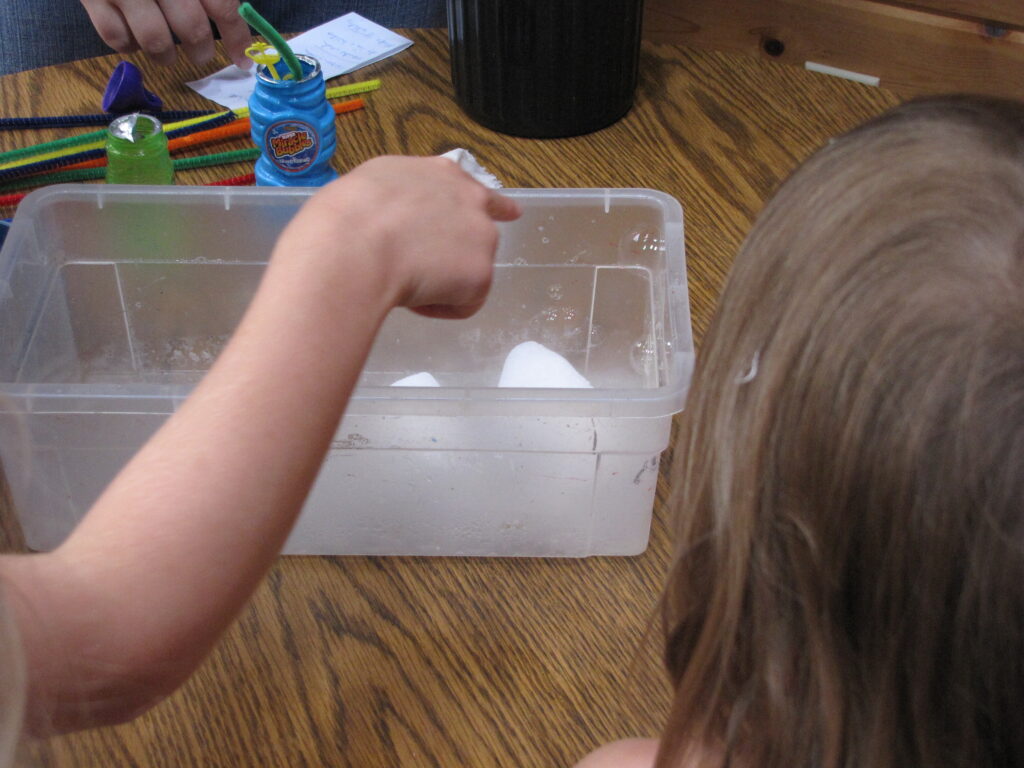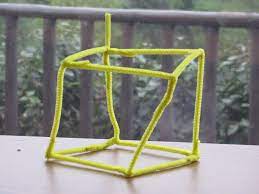 by: Michelle Bertke and Melanie Bunda
by: Michelle Bertke and Melanie Bunda
Bubbles are always a fun and interesting activity for kids of all ages. However, bubbles are not only fun, they are also an excellent teaching tool for some abstract concepts such as air density, dissolved gasses, and air pressure. Below is a collection of bubbly activities that highlight each of these topics. Educational Innovations offers a full line of wonderful bubble products!
Gravity Defying Bubbles
Different gasses have different densities. The air around us is mostly nitrogen (N2) and oxygen (O2), which are both lighter than carbon dioxide (CO2). When a heavy gas, such as CO2 is placed in a tank, it will sink to the bottom without mixing. This can be achieved by placing a few blocks of dry ice in a large fish tank or clear plastic bin covered loosely  with a lid and allowing them to sublime. This will take several minutes. Always use caution when handling dry ice by using proper gloves and safety goggles.
with a lid and allowing them to sublime. This will take several minutes. Always use caution when handling dry ice by using proper gloves and safety goggles.
Once full, blow bubbles over the surface of the tank. When the bubbles reach the interface of the two gasses, they will float. If you fill the tank with CO2 unnoticed, have the kids speculate as to why they think the bubbles didn’t reach the bottom, and what might be in the tank.
An alternative is to fill a balloon with CO2 by filling it with baking soda (or an alka seltzer tablet) and placing it over the opening of a bottle filled with vinegar (or water). Lift the balloon so the contents spill into the bottle and react with the liquid, allow the balloon to fill from the reaction, twist and remove. Use it to blow bubbles. Compare these bubbles to those blown with regular air (use a fan, not your breath for best results). Have students compare the two bubbles. Which one falls faster? Which one floats longer?
Dancing Raisins
All kids will know that soda pop is fizzy, but they may not know where all those little bubbles come from. This demonstration will highlight the dissolved gasses in soda. Fill a glass with a clear soda. As you pour in the soda (pour gently down the side to retain maximum fizziness in the liquid), you will see bubbles forming from the bottom and the sides of the glass. Ask the students why they think that bubbles only form in these places. Next, take a few raisins and drop them into the soda (you may need to break the raisins into smaller pieces). You will notice that bubbles immediately begin to form in the crevices of the raisins. As more bubbles collect on a raisin, it will begin to rise. When it reaches the top, the bubbles on the outside will escape into the air and this will cause the raisins to sink, and the cycle to begin again. Pretty soon you will have a glass of dancing raisins. This should raise discussion about dissolved gasses and buoyancy. Students can experiment with different sodas and different materials to see what may cause more or less bubbles to come out of solution.
 Mentos and Soda
Mentos and Soda
Another classic example of dissolved gasses is the Mentos and soda demonstration. This demonstration can be done by anyone with just a two liter bottle of soda and a pack of original Mentos. Make sure you are in an area which can get messy and sticky. Simply open the soda and the pack of Mentos. (Fashion a Mentos delivery apparatus out of a rolled up piece of paper to prevent getting sprayed.) Quickly drop the Mentos into the soda all at once and immediately step back. The ensuing fountain will go high into the air and cause widespread excitement. The same tests can be done as were mentioned in the raisins: what kind of soda makes the highest fountain? Do different types of Mentos cause differences in the height of the fountain?
Square Bubbles
All bubbles are round. Or are they? A free flying bubble, no matter what shape wand produced it, will always be round. Why is this? When you blow a bubble, the soap solution stretches as the air flows into it, and the air pushes equally on all sides of the bubble. This creates a perfectly spherical bubble with equal pressure on all sides. But what happens when the wand is a three dimensional cube? Make a cube frame out of pipe cleaners. (Make sure to attach a handle to hold on to.)
Fill a tall beaker with soap  solution and dip the cube into it, fully submerging it. Remove the cube from the container, and you will see a square “bubble” stretched between the sides of the form. If you blow on one side of the cube structure, the sides will collapse in on each other and come together at a point. Now take a straw and gently blow into the center of that point. If you get it just right, you can form a cubic bubble in a bubble! Give the students several pipe cleaners and allow them to create their own 3D bubble wands. See what other kinds of bubbles they can form.
solution and dip the cube into it, fully submerging it. Remove the cube from the container, and you will see a square “bubble” stretched between the sides of the form. If you blow on one side of the cube structure, the sides will collapse in on each other and come together at a point. Now take a straw and gently blow into the center of that point. If you get it just right, you can form a cubic bubble in a bubble! Give the students several pipe cleaners and allow them to create their own 3D bubble wands. See what other kinds of bubbles they can form.
Any way you look at it, either from a scientific point of view or as a kid on a sunny day, bubbles are a fascinating activity to be shared by all. Next time you are strapped for something to do, just whip up a batch of bubble solution and let your imagination run wild.